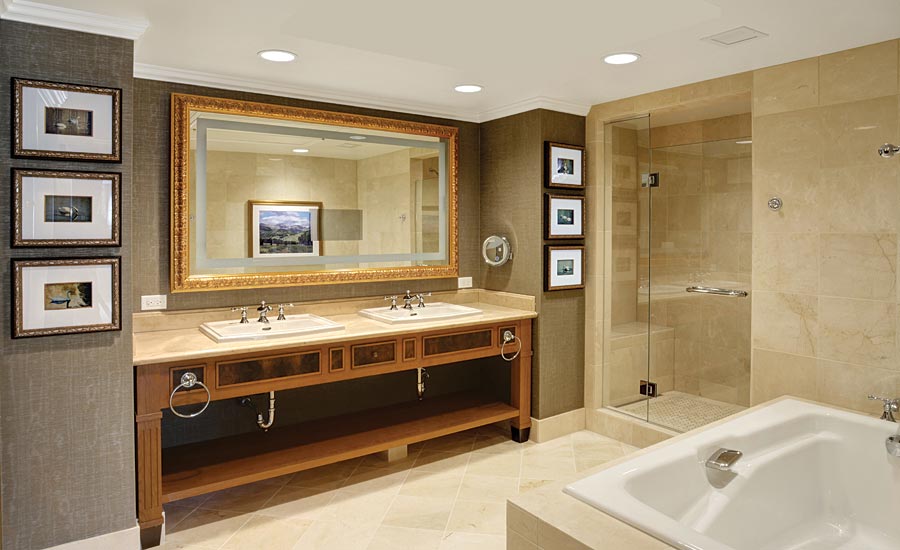Modular Bathroom Assemblies






Picture the last time you checked-in to a hotel. Chances are you arrived late in the day, stumbling into a darkened room with an armful of luggage. And, when you or a family member got up in the middle of the night to use the bathroom, given your unfamiliarity with the space, you likely bumped your way in there in the dark. From suitcases to disoriented travelers, repeated high humidity from guest use of the showers, and housekeeping taking cleaning carts in and out—day after day—the walls in hotel bathrooms must be built to withstand abuse.
Bathrooms Matter to Hotel Guests
Bathroom design and quality is one of the key drivers of hotel guest satisfaction. As New York Times travel reporter Stephanie Rosenbloom says, for guests, “the hotel bathroom is more than a place to freshen up. It’s considered an indicator of how upscale, current and clean a hotel is, an extension of its identity.”
Amplifying this point, Lionel Sussman, vice president of Marriott global design strategies, says in an interview with USA Today, “We’re spending more time focusing on bathrooms because so many of our customers have upgraded bathroom experiences in their own homes with fancy amenities, elaborate finishes and integrated technology.”
Because the bathroom is a focal point for guest satisfaction, yet is susceptible to scratches, dings and degradation from frequent use, having clean and solid walls is crucial for hotel owners and operators.
Building Walls for Longevity
Hotel owners, operators and real estate investment trusts know they’ll need to refurbish bathrooms at about the eight and 15 year marks after opening—starting with a soft refresh during the first cycle, and a hard refurbishment at the second cycle. Thousands of guests take their toll on bathroom walls over the years, plus design tastes and styles change.
Gary Fennell, director of facilities and construction for hotel developer and manager Plamondon Hospitality Partners, found his solution to the bathroom wall challenge by using durable, pre-fabricated modular bathrooms. In addition to helping satisfy guests with high quality facilities, the bathroom pods save Fennell time and money during hotel remodels.
A case in point is the recent remodel of the Plamondon-developed and managed Courtyard by Marriott in Hagerstown, Maryland. After seven years and an average 2,000 guests per room, there was no mold or water leaks in any of the hotel’s 100 guestroom bathrooms. “The bathrooms really have held up well; we didn’t have to remove any drywall—there’s no damage, mold or things we find all the time [in a conventional bathroom remodel],” says Fennell. Not needing to replace bathroom drywall helped Fennell shave off about two days per floor from the room refurbishment schedule. The result was lower labor time and costs, reduced construction waste and dumpster fees, plus a quicker return of the guestrooms to generating revenue. (Watch a three-minute video of Fennell discussing the remodel.)
The pre-fab bathroom pods Fennell used in the original hotel construction were Oldcastle SurePods. The durable materials in the pods that eliminated the need for drywall replacement include a patent-pending, fully waterproof and crack-proof “Ironcloud” ceiling, and USG Fiberock Aqua-Tough interior panels.
Why Hotels Choose Modular Bathrooms
Although simpler and lower cost refurbishment matters to hotel developers and owners, the driving factor behind their choice to use modular bathrooms built offsite usually comes down to construction schedule savings and higher quality.
In its “Smart Construction” report, professional services giant KPMG notes that offsite construction “offers a shortened and more reliable program,” with time savings of up to 6 months. Bathrooms are a prime beneficiary of modular efficiencies since building a typical bathroom requires 10 or more construction trades—including electrical, plumbing and finishing work ranging from drywall and painting to mirror hanging. Because so many workers come and go in a small space, there’s a huge risk of damage to previously completed work. Bathroom rework accounts for about 60 percent of the punch-list in most hotel projects, and can cause weeks of schedule delays. Building with pre-fabricated modular bathrooms eliminates that risk.
Such bathroom pods are built off-site in a controlled factory setting, then trucked to the job site for “plug and play” installation. A prime example is the new 612-room Omni Louisville Hotel that opened in March 2018. Despite the city’s tight labor market, which is exacerbated by construction of 10 new downtown hotels, the project team was able to open the 30-story hotel a month earlier than originally planned.
As they’re built in an indoor environment, pre-fab pods also create a higher-quality bathroom since they’re constructed to tighter tolerances than is possible on a job site. Hotel developers also like that they can specify any level of finish—up to five-star quality.
Conclusion
The next time you check-in to a hotel room, look in the bathroom. It might have been built in a factory hundreds of miles away, and you would never know it. But, no matter how long of showers you or other guests take, or how much horseplay the bathroom experiences from rambunctious kids, if it’s a prefab bathroom, chances are it will still look great year-after-year. W&C
Looking for a reprint of this article?
From high-res PDFs to custom plaques, order your copy today!









